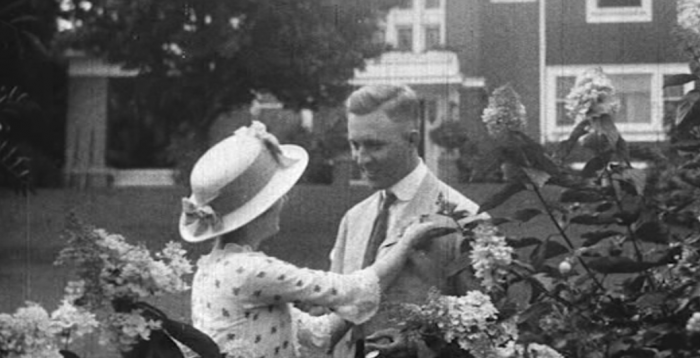
On the second half of Arts Extract’s two-part Wisconsin Film Festival preview, I highlighted a number of “Wisconsin’s Own” films I was looking forward to. I failed, however, to mention The Lumberjack and a program that may be among the most vital in this year’s festival.
Shot in Wausau in 1914, O.W. Lamb’s The Lumberjack clocks in at a brief 16 minutes and in the case of such brevity, a little context goes a long way. 100 years ago, movies were shorter, often packaged with magic shows and concerts, and calling them “moving pictures” didn’t make you sound like a weirdo. Yet The Lumberjack still feels quaint, more or less a series of appointments and arrangements between the titular character and a young woman. From races on the Wisconsin River to golfing at the local country club, its setting is as important as the period’s industrial upheavals. A locomotive rolls past the screen in an early shot as each train car, stocked with fresh lumber, envelops much of the frame. When our couple eventually ties the knot, their wedding party pours forth from the church doors in a similar fashion, their unidirectional procession nearly as long and looming as the train’s cargo.
Despite Lamb’s interest in our emotional and spatial relationships with place, the long-defunct Paragon Feature Film Company’s production could seem trite to the unenlightened viewer. Fortunately, it’s not the only piece in the “The Lumberjack at 100.” When You Wore a Tulip and I Wore a Big Red Rose, an accompanying documentary, digs up the film’s production history and subsequent rediscovery as it dissolves between buildings presented in The Lumberjack and their present-day condition — that is, if they’re still standing.
Beyond geography, the documentary interviews a host of colorful locals. Several women who lived in Wausau during the production recall the relationship statuses of cast members or bark orders at the projectionist as they fondly watch the film again. In a hilarious surprise, the son of The Lumberjack‘s onscreen couple kept his copy of the film in a metal canister inside his garage and minces few words over his dislike of mom and dad’s starring feature. A gung-ho pianist who once provided live accompaniment during exhibitions plays segments from her cracked and yellowed sheet music. (The documentary’s title is actually pulled from Jack Mahoney and Percy Wenrich’s number, a popular tune featured in original exhibitions of The Lumberjack.) Sections even feature a group of outdoor enthusiasts fishing hundred-year-old logs from the Wisconsin River — because what’s a Wisconsin film without a little natural history?
Upon a second viewing of The Lumberjack, I discovered that a short escapade through Wausau’s industrial boom found a new reflexiveness. There’s a historicity within The Lumberjack, most obviously for its city, but its real value (and if I were to guess, the reason for its inclusion beyond the 100 year milestone) is its linking of place and picture, a connection between time and the moving image. In the static shots and jump cuts of silent film lies a profundity, though this should be little surprise given some of the same folks infatuated with the physical medium at the Cinematheque are behind this year’s festival, too.
While out on the town, The Lumberjack’s Mr. and Mrs. survey Wausau’s skyline through a pair of binoculars. Lamb simulates their first-person perspective in a series of long takes, a slow and economical encapsulation of the town via however many frames per second. The transfer’s pock marks and the arresting absence of sound are reminders that, despite changes we experience over time, film retains a perpetuity and permanence. Back in 1914, the “moving pictures” were a marquee event that stirred the imaginations of those fortunate enough to watch them. Certainly, The Lumberjack meant a great deal to the townsfolk, but 100 years later, the film gains a different dimension of importance; now, it’s also a look back. As fun and varied as the films are in this year’s “Wisconsin Own” selections, I’m not sure there’s one more essential than this.
- “The Lumberjack at 100″ also features a 1933 comedy short shot right here in Madison. As of this writing, advance tickets are still available for both the April 5 and 6 screenings.
